Given the havoc that COVID-19 is causing with global supply chains, manufacturers have arguably never needed to regroup and rethink how they source parts more than they do now. However, the pandemic has also prevented large swathes of the 3D printing community from gathering, sharing ideas and identifying opportunities to address this, with Rapid+TCT called off in 2020 and smaller than usual last year.
With that in mind, it was a relief to find that the 2022 edition of the event was back at full capacity, and jam-packed with new, innovative products, as well as engineers willing to explore their functionalities. To make sure that those unable to attend didn’t miss out, 3D Printing Industry’s own Paul Hanaphy attended the event in full, and has put together a rundown of the show’s highlights below.

Better meeting manufacturers’ needs
Fittingly, Rapid+TCT, hosted this year at Huntington Place in Detroit, opened with a keynote delivered by Siemens CEO Barbara Humpton on the ‘glocalization’ of US production. During the speech, Humpton not only highlighted the need for greater insourcing by manufacturers as a means of reinforcing the country’s supply chains, but the potential of 3D printing to help facilitate this shift as well.
As it turned out, the keynote’s focus on the need for innovation to overcome supply issues was reflected on the show floor, with the likes of SPEE3D showcasing the rapid deployment capabilities of its LightSPEE3D. The machine has been used by the Australian Army in many field trials, and the firm’s CEO Byron Kennedy was on-hand at its booth to explain how it’s now helping keep military vehicles on the road.
At the stand, Kennedy showed off a battery connector which usually takes 16 weeks to produce and ship, but with SPEE3D 3D printing, it can be made inside ten minutes. What’s more, the CEO added that post-processing the component is simple and quick, before going on to perform the process himself in front of attendees.
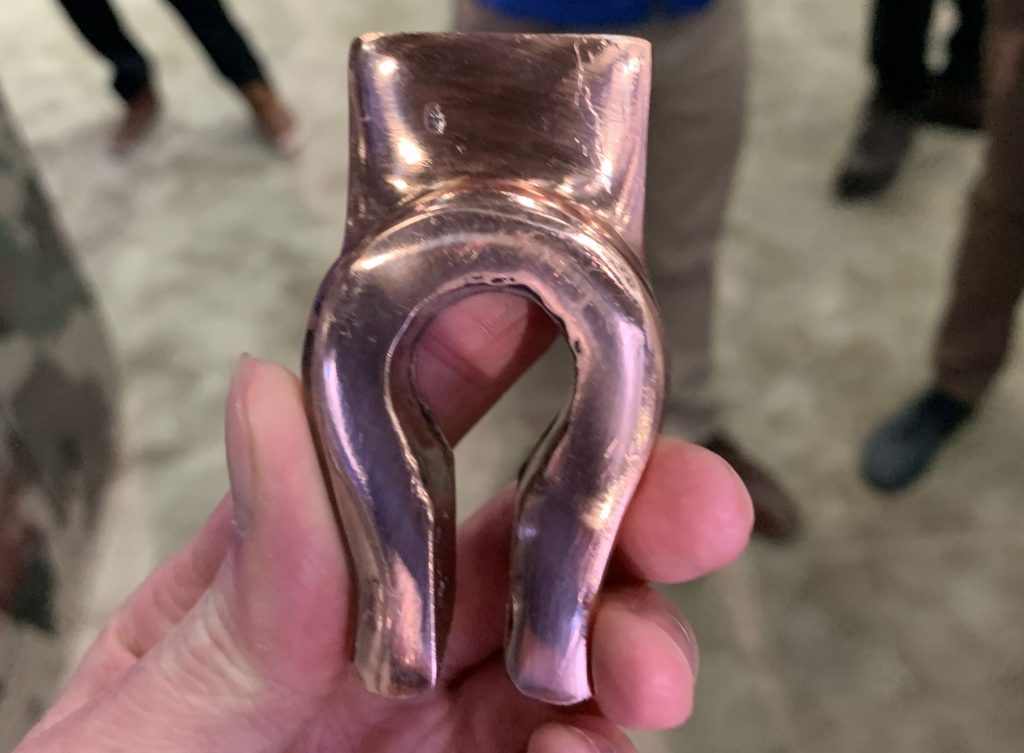
Elsewhere, Pantheon also featured a machine boasting rapid manufacturing capabilities. Known as the ‘HS3,’ the industrial-grade system is said to be five times faster than comparable 3D printers. While the machine is slated for a Q3 2022 launch, the Canadian start-up has already begun working with clinicians, with the aim of helping them digitize and begin insourcing their supply of medical parts.
“We’re actually working with a couple of groups already on digitizing supply chains,” explains Pantheon CEO Bob Cao. “Right now we have a project with Vancouver General Hospital, where we’re essentially creating a digital inventory of plastic medical goods. We’re also looking at some things in the defense sector. That’s starting to really blow up for us, and speed is enabling that to be possible.”
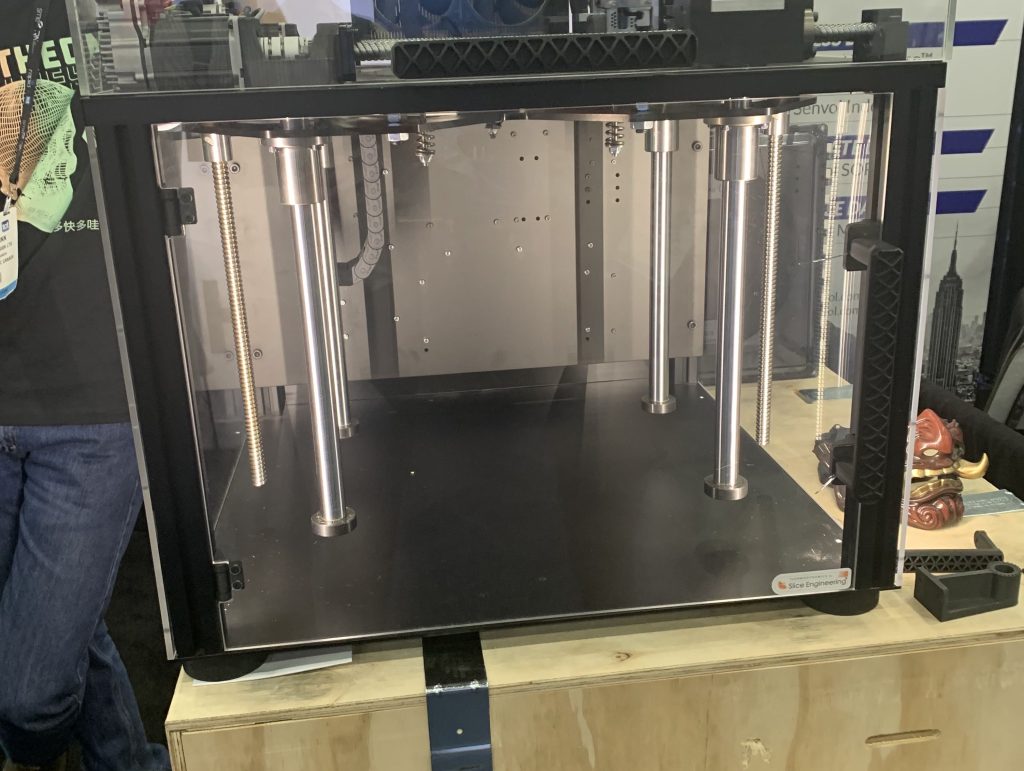
Edging towards material sustainability
Another trend that popped up multiple times throughout the show was material sustainability, with an entire AMGTA-sponsored panel being dedicated to the topic on day two. During the discussion, 6K Additive’s Frank Roberts said there needs to be a “little less conversation and a little more action” on reducing waste, before later at his firm’s booth, explaining how its technology is driving a change for the better.
Going into further detail on the company’s UniMelt system, Roberts shared how the microwave plasma technology converts millings and turnings into metal powders. Using the process, the company’s President said that it’s now able to produce nickel while using 91% less energy to do so, and reducing emissions by as much as 91.5%, when compared to conventional induction furnace gas atomization.
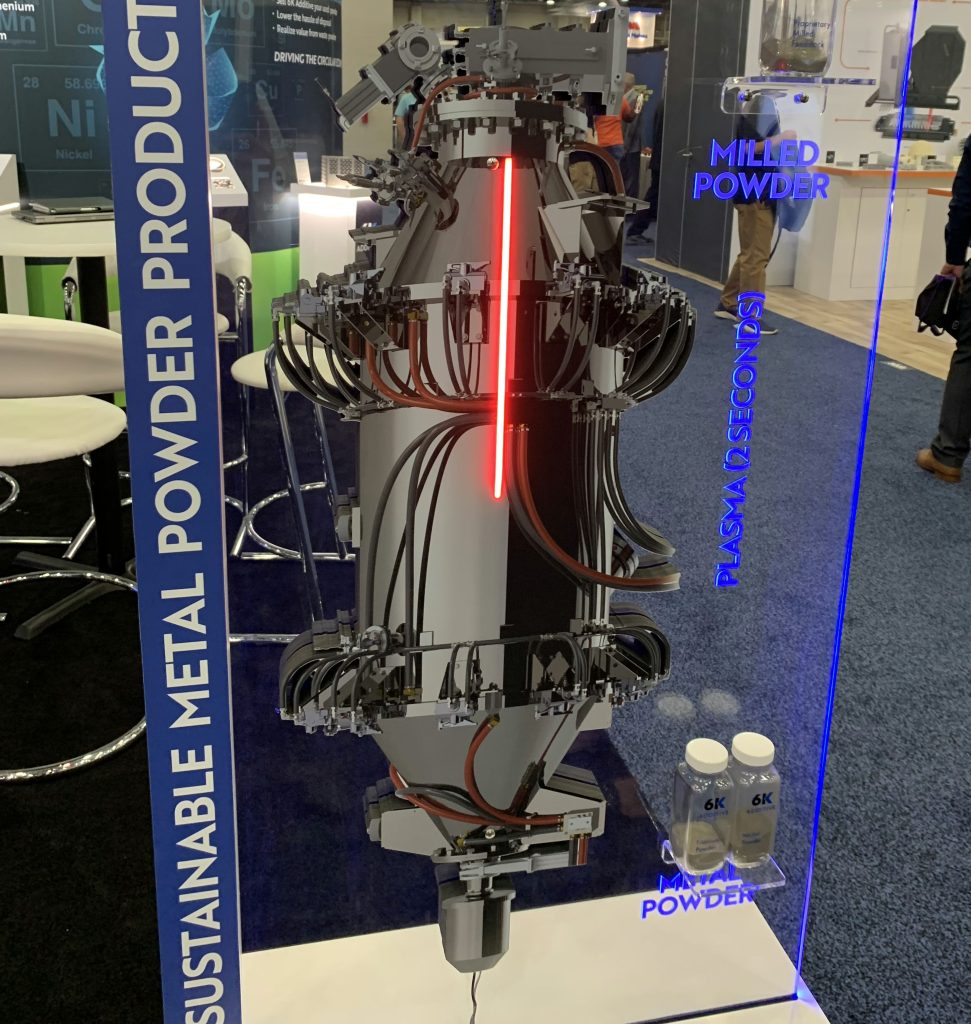
There were also a range of sustainable materials on-show at the event, with Polymaker displaying its PolyTerra PLA. Speaking to 3D Printing Industry at the show, the firm’s Marketing Manager Luke Taylor claimed that the polymer targets eco-friendliness on many fronts. Not only is the filament bio-based and sold on cardboard holders, but the company pledges to plant a tree for each spool sold.
In terms of new launches, Braskem debuted its first-ever sustainable 3D printing filament range at the show. Released in the run-up to the event, the materials are available in ethylene vinyl acetate (EVA), recycled polyethylene (PE) and polypropylene (PP) variations. On the show floor, Alexandre Luz, an Innovation and Technology Leader at the company, said that each of these is made from sugarcane-sourced ethylene, making them eco-friendly but not at the expense of end-part performance.
Likewise, Jabil released PK 5000 at the event. By sequestering carbon monoxide and turning it into a solid form, the polymer is said to be both more sustainable than nylons like PA12, and stronger with greater chemical resistance. Designed for use with Selective Laser Sintering (SLS) machines, the polymer can be used to create sliding, clipping and connector parts, many of which were on-show at the booth.
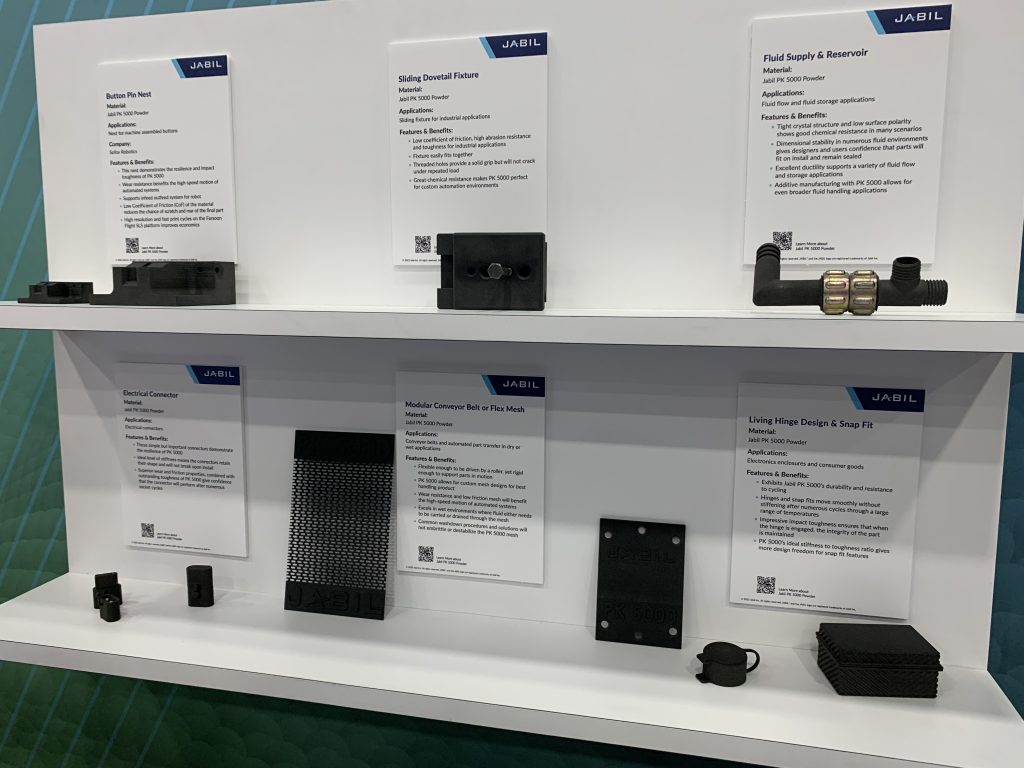
Addressing AM’s data challenges
On the event’s third day, a panel hailing from various 3D printing software-developing leaders including Siemens, Autodesk, Hexagon and Materialise, then went on to capture another of the show’s main trends: how best to utilize the reams of data now captured and stored by 3D printing manufacturers across the industry.
While the insightful discussion covered everything from file format benefits to encryption, the presence of Materialise’s VP and GM Bryan Crutchfield was significant given its launch of the CO-AM platform at Rapid+TCT.
Speaking to the firm’s Software Marketing Director Hans Van Glabeke at its booth that day, I was told that CO-AM enables the creation of a ‘data lake,’ that is capable of communicating with any integrated production tools. The platform is open to third-party app integration, even those that replace Materialise’s own products, and it has already partnered with CASTOR and AM-FLOW to facilitate this functionality.
The latter also had a prominent display and news of its own collaborative product launch at the show, in the form of its new AM-QUALITY offering. Being developed alongside Oqton, the system is effectively capable of detecting print errors like sinkholes that may not be identified during manual part inspection. Right now, the technology is only available for small-scale lab-based applications, but the team on AM-FLOW’s booth said they aim to make it compatible with AM-SORT soon.
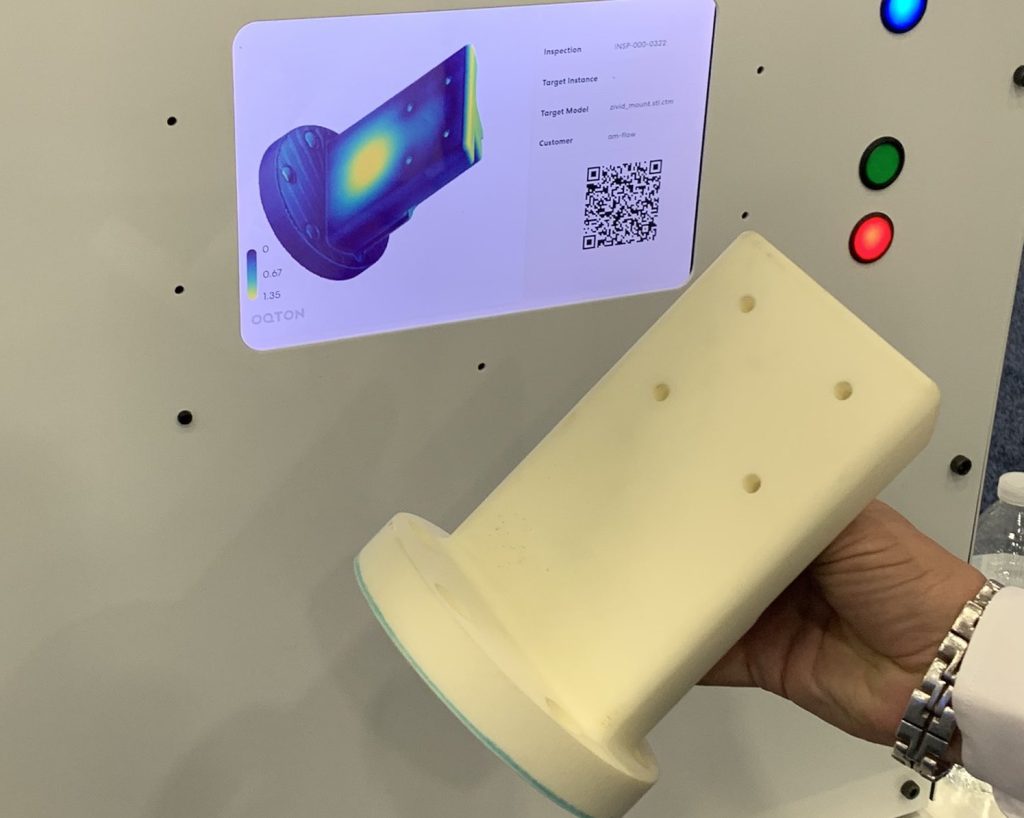
Scaling new highs and lows
As with many 3D printing shows, some of the most attention-grabbing booths at Rapid+TCT featured machines and prints that scaled new heights. The Thermwood Corporation’s display was particularly impressive, in that one of its LSAM systems was being used to create a huge build in live-action. The firm also had a massive BELL helicopter blade mold on-show that took just three hours to print.
In a similar vein, at Sciaky, its VP of Marketing Robert Phillips said Lockheed Martin has managed to use one of its systems to create the bottom half of a large satellite propellant tank. According to Phillips, the defense contractor, which is now part of Biden’s AM Forward initiative, is able to realize such builds thanks to a “natural advancement of the technology” that has taken place over the last decade.
Meanwhile, at the opposite end of the scale, Nano Dimension showcased the capabilities of its Fabrica 2.0 machine alongside a range of highly-accurate, tiny parts that, when viewed through a microscope, had visible 50 micron-sized holes.
Engineers at Azoth also spoke of their improved small part production capabilities as part of a media tour of their facility, the night before the event started. At the site, which features XJet’s first installed Carmel 1400M, the team explained how the system’s ability to produce parts with “fine tolerances” and “complex overhangs” could now enable them to address new customers with higher-throughput needs.

Getting up close and personal
As you’d expect, one of the other benefits of attending Rapid+TCT in-person, was that it provided the opportunity to get up close and personal with new systems launched in the run up to the show. There were a myriad of these machines and technologies on display, many of which revolved around advances in metal 3D printing, with the likes of Desktop Metal showcasing its ExOne S-Max Flex offering.
By fitting its new 3D printer with a Single Pass Jetting printhead-mounted ABB robotic arm, the firm says it has managed to halve the unit’s cost, and make it accessible to a wider audience. Thanks to its modular architecture, foundry and pattern shop adopters should also be able to scale their capabilities as they grow, while its build rate of 115 liters per hour enables industrial core and mold production.
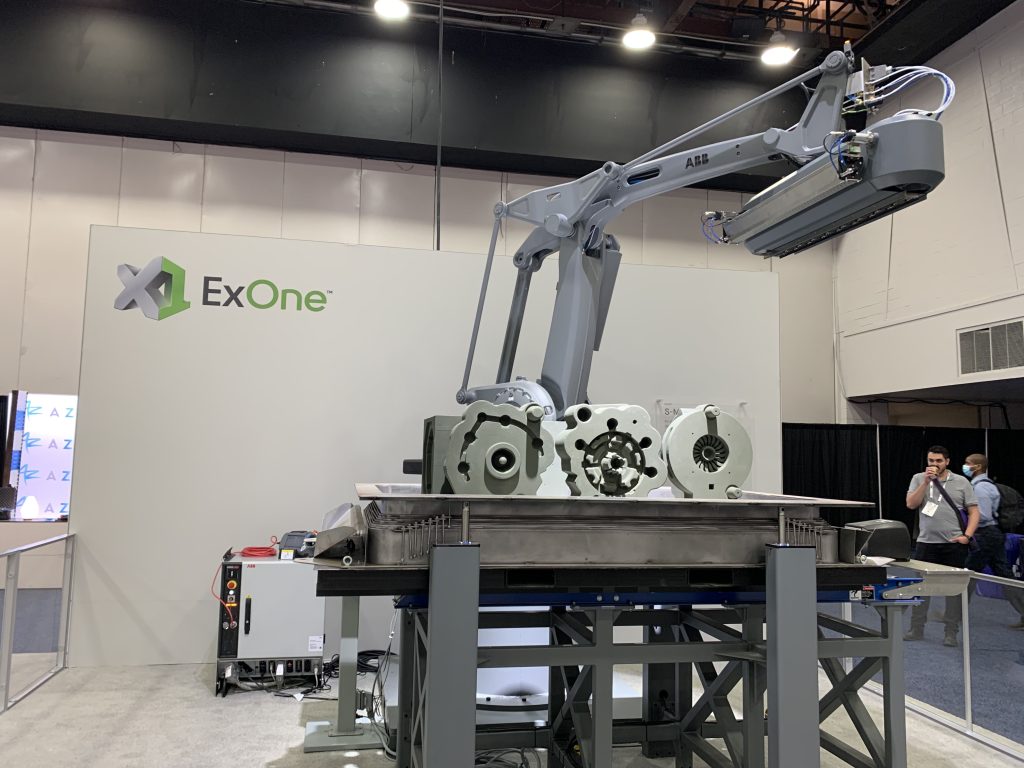
Similarly, Xact Metal showcased another cost-conscious 3D printer at the event, in the shape of the XM200G2. At the firm’s booth, one of its distributors explained that the 150 x 150 x 150 mm build volume unit’s galvanometer system enables it to support multi-laser setups, but even with its beefed-up specs compared to the original XM200G, it can still be bought and installed for a total of just $110,000.
At Digital Metal, meanwhile, the company was exhibiting its DMP/PRO machine. Fitted with a platform-wide printhead, the system is said to be 2-4 times faster than its predecessor, and thanks to its ‘cleaner’ handling of powder than other similar 3D printers, it’s capable of printing titanium without needing to do so inside an inert gas-filled chamber. Though the machine won’t be released until late-2022 to early-2023, the word from the firm’s booth team was that it had already sold two units.
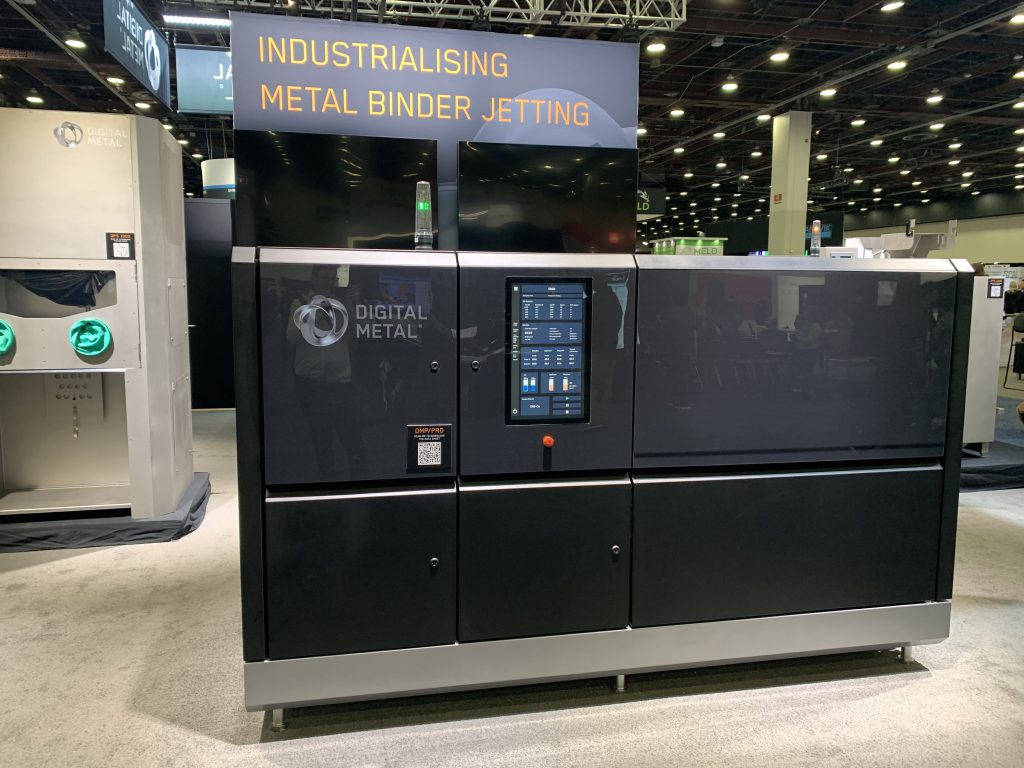
Alongside these technologies, launched by established metal 3D printing names, optical equipment manufacturer JEOL also made a splash with its JAM-5200EBM system. Making its way onto US soil for the first time this month, the Electron Beam (EBM) 3D printer is capable of creating builds up to 400mm x 250mm in size from ‘exotic alloys,’ hence the firm is targeting it towards aerospace manufacturers.
Interestingly, at the booth, JEOL’s President Bob Pohorenec added that people are starting to “see the value potential” in EBM, driving new entries to the market. “There hasn’t been a lot of innovation since the beginning, but that looks like it’s changing,” said Pohorenec. “The initial entry was Arcam, they’ve made innovations, now Wayland Additive’s in it, we’re in it, a large number of companies are jumping on it.”
Lastly, on the polymer front, BCN3D provided another glimpse into the capabilities of its new Viscous Lithography Manufacturing (VLM) technology. VLM-equipped 3D printers are said to be capable of processing resins 50 times more viscous than industry-standard ones, paving the way for ultra-high-strength parts with a mixture of flexible and rigid elements.
Although these machines weren’t on display at the show, a number of demo parts produced using them were, including some of the 7,000 Saint-Gobain was able to create as part of a pilot project. Using the technology, the company manufactured these over seven days at a cost of just $0.86 per piece. BCN3D’s team said that it continues to work with over 400 manufacturers regarding VLM applications via its ‘TAP’ program, with further developments expected in due course.
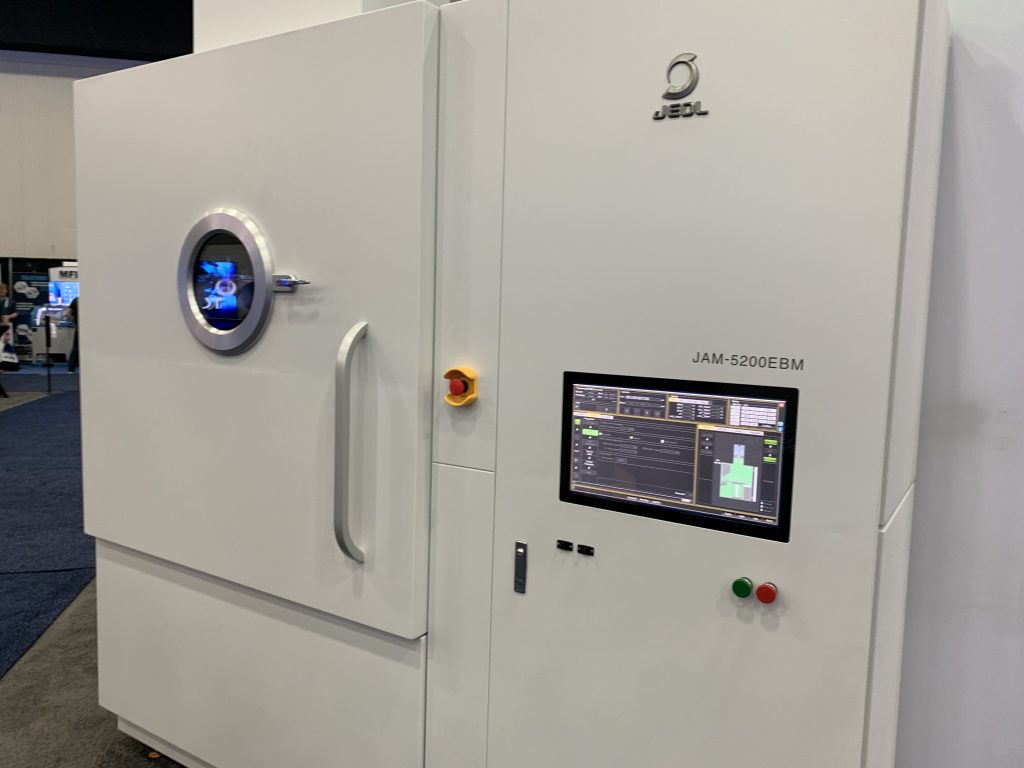
To stay up to date with the latest 3D printing news, don’t forget to subscribe to the 3D Printing Industry newsletter or follow us on Twitter or liking our page on Facebook.
For a deeper dive into additive manufacturing, you can now subscribe to our Youtube channel, featuring discussion, debriefs, and shots of 3D printing in-action.
Are you looking for a job in the additive manufacturing industry? Visit 3D Printing Jobs for a selection of roles in the industry.
Featured image shows the entrance to Huntington Place, Detroit at Rapid+TCT 2022. Photo by Paul Hanaphy.


